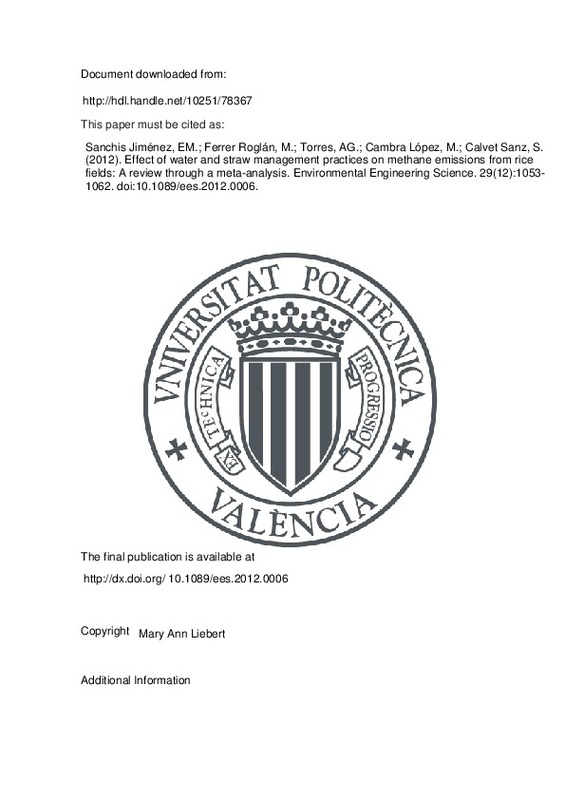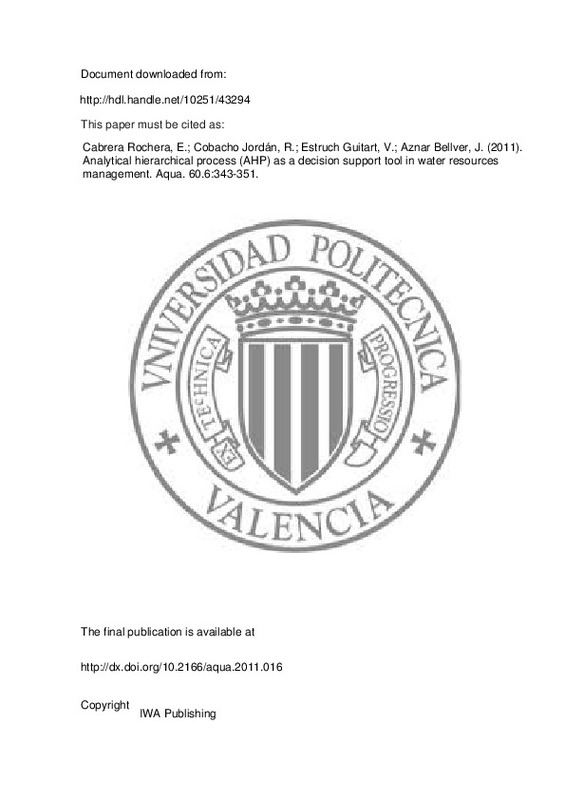Sanchís Jiménez, EM.; Ferrer Roglán, M.; Torres, AG.; Cambra López, M.; Calvet Sanz, S. (2012). Effect of water and straw management practices on methane emissions from rice fields: A review through a meta-analysis. Environmental Engineering Science. 29(12):1053-1062. https://doi.org/10.1089/ees.2012.0006
Por favor, use este identificador para citar o enlazar este ítem: http://hdl.handle.net/10251/78367
|
Título:
|
Effect of water and straw management practices on methane emissions from rice fields: A review through a meta-analysis
|
|
Autor:
|

 Sanchís Jiménez, Elena María
Ferrer Roglán, Marta
Torres, Antonio G.
Sanchís Jiménez, Elena María
Ferrer Roglán, Marta
Torres, Antonio G.

 Cambra López, María
Cambra López, María

 Calvet Sanz, Salvador
Calvet Sanz, Salvador
|
|
Entidad UPV:
|
Universitat Politècnica de València. Instituto de Ciencia y Tecnología Animal - Institut de Ciència i Tecnologia Animal
Universitat Politècnica de València. Escuela Técnica Superior de Ingeniería Agronómica y del Medio Natural - Escola Tècnica Superior d'Enginyeria Agronòmica i del Medi Natural
|
|
Fecha difusión:
|
|
|
Resumen:
|
[EN] Rice fields contribute substantially to global warming of the atmosphere through emission of methane (CH4). This article reviews the state of the art of factors affecting CH4 emissions in rice fields, focusing on soil ...[+]
[EN] Rice fields contribute substantially to global warming of the atmosphere through emission of methane (CH4). This article reviews the state of the art of factors affecting CH4 emissions in rice fields, focusing on soil organic matter content and water management practices. A quantitative relationship between these factors was established through a meta-analysis based on a literature survey. This relationship can be useful to update emission factors used to estimate CH4 in the National Emission Inventories. Methane emissions in rice fields can be as much as 90% higher in continuously flooded rice fields compared with other water management practices, independent from straw addition. Water management systems that involve absence of flooding in total or for part of the growing period such as midseason drainages, intermittent flooding, and percolation control, can reduce CH4 emissions substantially. Moreover, CH4 emissions increase with the amount of straw added up to 7.7 t/ha for continuously flooded soils and up to 5.1 t/ha for other water regimes. Above these levels, no further increase is produced with further addition of straw. With regard to rice straw management mitigation strategies, recommended practices are composting rice straw, straw burning under controlled conditions, recollecting rice straw for biochar production, generation of energy, to be used as a substrate, or to obtain other byproducts with added value. This review improves the understanding of the relationship between straw application rate, water regimes, and CH4 emissions from rice fields to date. This relationship can help to select the most appropriate management practices to improve current mitigation strategies to reduce atmospheric CH4. © 2012 Mary Ann Liebert, Inc.
[-]
|
|
Palabras clave:
|
Atmospheric pollution
,
Greenhouse gases
,
Paddy field
,
Regression modeling
,
Water regime
,
Added values
,
Application rates
,
Biochar
,
Controlled conditions
,
Effect of water
,
Emission factors
,
Flooded rice
,
Flooded soil
,
Growing period
,
Literature survey
,
Management practices
,
Meta-analysis
,
Methane emissions
,
Mid-season drainage
,
Mitigation strategy
,
National emission inventories
,
Paddy fields
,
Recommended practice
,
Rice fields
,
Rice straws
,
Soil organic matter contents
,
State of the art
,
Straw management
,
Water management systems
,
Byproducts
,
Floods
,
Global warming
,
Methane
,
Solvents
,
Substrates
,
Water management
,
Water pollution
,
Factor analysis
,
Organic matter
,
Water
,
Agriculture
,
Atmosphere
,
Combustion
,
Flooding
,
Greenhouse effect
,
Greenhouse gas
,
Irrigation (agriculture)
,
Methanogenesis
,
Nonhuman
,
Plant
,
Review
,
Rice
,
Rice field
,
Soil
,
Straw
|
|
Derechos de uso:
|
Reserva de todos los derechos
|
|
Fuente:
|
Environmental Engineering Science. (issn:
1092-8758
)
|
|
DOI:
|
10.1089/ees.2012.0006
|
|
Editorial:
|
Mary Ann Liebert
|
|
Versión del editor:
|
http://dx.doi.org/ 10.1089/ees.2012.0006
|
|
Código del Proyecto:
|
info:eu-repo/grantAgreement/UPV//PAID-06-11-1950/
|
|
Agradecimientos:
|
This study was financially supported by Fundacio´n Agroalimed from the Consellerı´a de Agricultura of Valencia, Spain and the Vicerrectorado de Investigacio´n of the UPV (Programa de Apoyo a la Investigacio´n y Desarrollo, ...[+]
This study was financially supported by Fundacio´n Agroalimed from the Consellerı´a de Agricultura of Valencia, Spain and the Vicerrectorado de Investigacio´n of the UPV (Programa de Apoyo a la Investigacio´n y Desarrollo, PAID06-11 Program, Project No. 1950).
[-]
|
|
Tipo:
|
Artículo
|







![[Cerrado]](/themes/UPV/images/candado.png)



